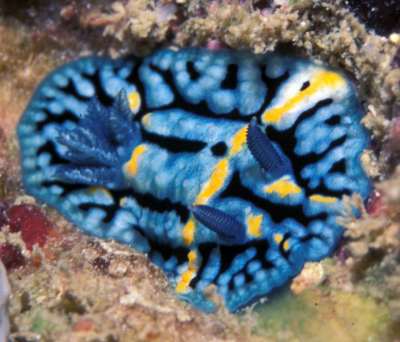

Aldisa andersoni
Gosliner & Behrens, 2004
Order: NUDIBRANCHIA
Suborder: DORIDINA
Superfamily: EUDORIDOIDEA
Family: Aldisidae
DISTRIBUTION
Known only from Sri Lanka
PHOTO
Pigeon Island, Trincomal, Sri Lanka, 8m. 7 March 1995. Photos: C. Anderson.
The living animals are 20-30 mm in length. The body is oval and the notal surface covered with a series of low conical tubercles. The tubercles form distinct ridges running longitudinally along the center of the notum, and perpendicular laterally along the margin of the notum. Rows of these tubercles are situated in regions of opaque blue pigment. These regions are separated by areas of black. There is an opaque, bright yellow saddle across the notum behind the rhinophores. This saddle extends right to the edge of the mantle. A few bright yellow patches may partially encircle the gill pocket. Some specimens have yellow patches posterior to the rhinophores.
It is similar in coloration to Aldisa albatrossae, Aldisa williamsi and Aldisa erwinkoehleri, but differs in a number of characteristics. In Aldisa andersoni, the low conical tubercles are clearly arranged in rows or ridges. Tubercles on the notum of Aldisa albatrossae, A. williamsi and A.erwinkoehleri are randomly distributed. The black coloration on A. williamsi and A. erwinkoehleri forms concentric rings, and in A. albatrossae forms a rectangle on the dorsum with a T-shape mark anterior to the rhinophores. In A. andersoni, the black pigmentation is found uniformly over the mantle separating the rows of tubercles. The opaque yellow pigmentation on Aldisa andersoni is quite similar to that found on A. albatrossae and A. erwinkoehleri. There are however consistent differences which clearly separate them. A. williamsi has no yellow pigmentation. The yellow pigmentation covers the tubercles in A. erwinkoehleri and in A. andersoni, but not in A. albatrossae, where it occurs between the tubercles. The yellow
color markings on A. andersoni are far more extensive than in the other species, with a yellow saddle extending to the very edge of the mantle that is not isolated into smaller broken patches, as in A. erwinkoehleri. The rhinophores differ in color between all four species. In A. albatrossae they are white-grey; in A. williamsi pale brown; in A. erwinkoehleri black, while in A. andersoni they are the same blue as the body. The arrangement of tubercles around the rhinophoral pockets differs among the four species.
Aldisa albatrossae has four similarly sized equally separated tubercles; A. erwinkoehleri has two large and two small tubercles while A. andersoni and A. williamsi have two equally sized tubercles, separated on either side of the pocket. Differences exist also in the tubercles around the gill sheath. A. albatrossae has a double row of tubercles; A. williamsi has a single row of eight tubercles; A. erwinkoehleri a single series tubercles while A. andersoni has a single series of twelve tubercles around the sheath.
Reference:
• Gosliner, T. M. & Behrens, D. W. (2004) Two of New Species of Dorid Nudibranchs (Gastropoda, Opisthobranchia) from the Indian Ocean. Proceedings of the Californian Academy of Sciences, 55(1): 1-10.
Behrens, D.W., 2004 (July 9) Aldisa andersoni Gosliner & Behrens, 2004. [In] Sea Slug Forum. Australian Museum, Sydney. Available from http://www.seaslugforum.net/factsheet/aldiande
